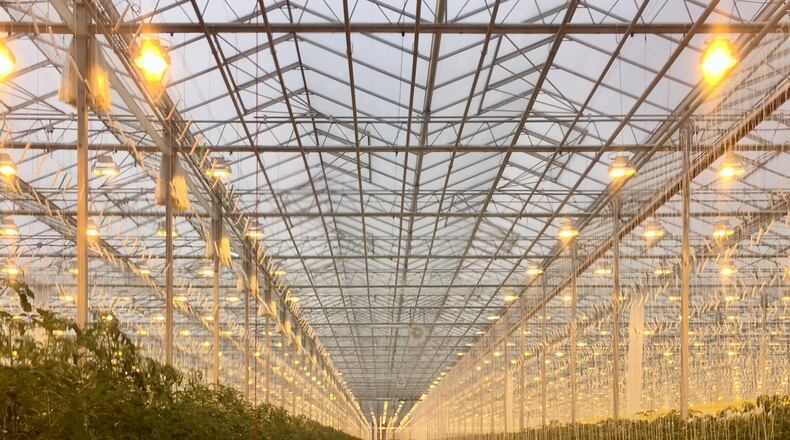During the next 10 years, Red Sun Farms based in Kingsville, Ontario, wants to construct 200 acres of greenhouses at the site. The completed facility would create 400 jobs with an annual payroll of $15 million.
“It’s a tremendous project for this area and will be a source of pride for this city and county for years to come,” said Greg Myers, director of the Wapakoneta Area Economic Development Council.
This first phase of the project will create 82 full-time jobs (42 year-round and 40 seasonal) with an annual payroll of $2.9 million. Two more greenhouses are planned by 2018 with construction of the second one beginning this year, Myers said.
“The cost of a project like this is really high, so we need to generate some revenue. It might be a year, it might be two, but we’ll definitely be working sooner than later on building additional greenhouses,” said Jim DiMenna, president of Red Sun Farms.
The first greenhouse has more than 9,000 lights that provide “sunlight” 24/7 that can be seen from miles away at night. The facility is expected to yield 16 million pounds of tomatoes a year, the company said. Red Sun Farms is the fifth-largest grower of tomatoes in the world.
Nothing is planted in dirt in the greenhouse, which uses a vertical hydroponic growing process. Every plant has its own tube that delivers water and nutrients through a computer software process.
The company, which operates farms in Canada, Mexico and the U.S., also grows peppers, cucumbers and eggplants at other farms. The company has planted one row of peppers at the Wapakoneta farm that it is testing with a new process.
During the growing process, the company uses 90 bee hives to help with pollination. The company wants to the entire process to be as natural as possible. No motor vehicles are used in the facility.
“When I toured it one day, it was dreary and snowy outside. When you get inside all of the glass with natural light, it’s like you’re out in the farm field with the smell of plants and bees buzzing around you,” Myers said.
Workers, called packers, will use scissor lifts to pick tomatoes from plant stalks that can grow up to 40 feet long. The growing season will last from August through May.
Packers will be able to pick the produce one day and have it on the grocer’s shelf the next. The produce is sold at grocers like Kroger, Walmart, Aldi’s and Meijer.
“It accesses plenty of our retail clients present and hopefully, more in the future; Ohio has been very receptive in the development of this project,” DiMenna said.
After each season, workers will remove the plants and restart the process. The facility has a 26,000-square-foot distribution center that allows the company to store other produce until they need to ship it to stores.
“It’s a source of pride because this is how thousands of Americans will be fed on a daily basis,” Myers said.
FIVE FAST READS
• New Elder-Beerman shops opening in Dayton
• Low-cost air carrier offers $65 trip to Europe
• Parent company of T.J. Maxx, HomeGoods to open new home store
• Wendy's to add self-ordering kiosks in Ohio stores this year
• Jewelry store to open at Town & Country in Kettering
The development of the site has been a plus to Wapakoneta as it has allowed it to upgrade its electric and natural gas service to the city. The company also said it paid $11 million to local construction crews and suppliers to build the facility.
The first 20-acre greenhouse will use 10 megawatts of electricity annually. By comparison, the city of Wapakoneta uses 32 megawatts a year, according to Myers.
The facility will use water from Wapakoneta and reclaimed rainwater that runs off the greenhouses and other structures. Golden Fresh Farms officials plan to provide a training ground for students from Ohio State University and Massachusetts Institute of Technology.
Plans also are in the works to partner with the Neil Armstrong Air and Space Museum on school tours.
“Agriculture right now, before this investment, was $105 billion worth of economic activity, one out of every seven jobs, and with something like this, hopefully that will raise that up a little bit,” said David Daniels, director of the Ohio Department of Agriculture.Reporter Steve Baker contributed to this story
About the Author


